Candied Orange Slices
Soft and chewy Candied Orange Slices are perfect for garnishing your favorite desserts and drinks, especially with this glossy version! Or cover them in chocolate for a fun treat!
Bursting with a sweet citrus flavor, these Candied Orange Slices have a soft inside pulp and a chewy outer rind that is completely edible. Not only are these candied citrus slices delicious, they are pretty enough to decorate your desserts and drinks! Try them on fancier cakes, as cocktail garnishes, or even chocolate-covered orange slices for a special treat.
Candied Orange Slices are easy to make and you’ll even get an orange flavored simple syrup you can use afterward. And they are created simply by boiling thin slices in sugar syrup then cooling–the details are below.
Did you know that citrus peels are more nutritious than the juice? According to Healthline, “orange peels are also rich in several nutrients, including fiber, vitamin C, and plant compounds like polyphenols. In fact, just 1 tablespoon (6 grams) of orange peel provides 14% of the Daily Value (DV) of vitamin C — nearly 3 times more than the inner fruit. The same serving also packs about 4 times more fiber.”
What are Candied Fruits?
Candied fruits are either whole fruits or pieces of fruits that are boiled in sugar syrup, and left to crystallize for a sweet treat. There are many different fruits that are used for this process such as dates, cherries, grapes, ginger root, and citrus fruits.
Candied Fruit vs. Dried Fruit
Although the candied and dried fruit are closely related, they are very different. Candied fruits, as discussed earlier, are heated in simple syrup to preserve through the displacement of water by sugar. Dried fruit is created by the process of dehydration either by sun-drying the fruits or using an oven or dehydrator. They’re preserved simply because of the reduction in water content. Candied fruits are sweeter and often moister, which for citrus, means you can even eat the normally discarded peel! 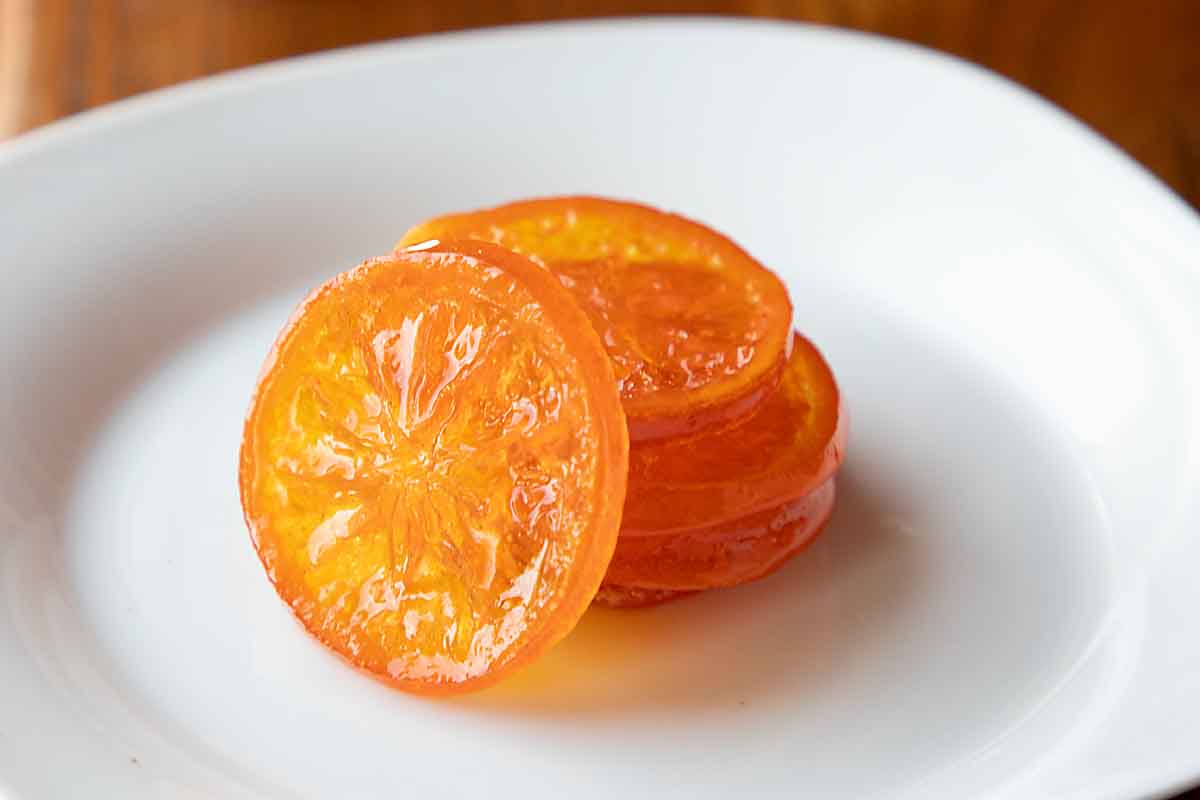
Why You’ll Love This!
A lovely garnish. Candied orange slices are a convenient decoration that is both pretty and edible–and which can easily elevate your cake design.
Delicious treat. Eat them as is or dip them in chocolate for a delicious treat.
Easy to make. With only a few ingredients and simple steps, you’ll soon be using these candied orange slices all over!
What You’ll Need
Ingredients and Notes
- Granulated sugar. Along with water, this makes the simple syrup that is used to candy the citrus slices.
- Citrus. A variety of citrus can be used but kumquats and mandarin oranges are especially nice. Smaller citrus fruits are less likely to break apart when boiled. Fruit should be cut about 1/8 inch thick and the ends discarded.
Special Tools
- A sharp knife or mandolin to thinly cut the slices.
- A digital thermometer to check the temperature of the simple syrup.
- A wire rack or parchment paper to set the candied orange slices on to cool
Step by Step Directions
Make your simple syrup. In a saucepan, combine sugar and water. Stir until combined, then heat on medium until the mixture reaches approximately 225F.
Pre-boil the orange slices in water to reduce bitterness. While the syrup is heating, bring a couple of cups of water to a boil in a separate saucepan. Drop in the orange slices and boil for two minutes. After two minutes, remove orange slices to an ice bath to cool.
Boil the orange slices in the simple syrup. When the sugar mixture reaches 225F, add the boiled and cooled citrus slices and adjust the heat to a low boil. When the syrup reaches 245-250F, take the pan off the heat. Use a fork to remove the slices one at a time and set them onto a wire rack.
Let them cool and solidify for 30-60 minutes.
Garnish your cake with Candied Orange Slices or enjoy a tasty snack!
Conquering Candied Orange Challenges
There are a few challenges making candied citrus that are easy to conquer if you know how!
The first challenge is keeping the slices from shredding in the boiling sugar syrup. Here, using smaller diameter slices is helpful. Kumquats, limes (Key and Persian limes), lemons and mandarin oranges all worked well.
The other useful technique is to wait until the syrup reaches 225 F before adding the fruit. This reduces the time the fruit is rolling around in the sugar bath, but still allows plenty of time for the sugar to infuse.
The second challenge is delivering a slice that is sugary, pliable, tacky and glossy. This is achieved by removing the slices when the syrup is in the “firm ball” stage (245-250F). At this stage, a drop of cooled sugar syrup forms a ball that holds together but can be flattened since it is still pliable. This means that the syrup doesn’t run off the orange slice like pancake syrup would, yet is still soft and chewy.
To learn more about candy making, take a look at Pistachio Brittle without Corn Syrup which discusses the general candy-making process, how sugar changes as it cooks, and crystallization. 
How to Serve
There are many ways to use and serve these Candied Orange Slices. Here are some of our favorite ways:
- You can eat them as candy as is or coat them in sugar
- Use to decorate your cakes, cupcakes or muffins
- Use them as colored glass windows on your gingerbread house
- Garnish your cocktails and non-alcoholic drinks
- Cover or dip in chocolate for an even more special treat
And consider wrapping some up to give as a gift for the holidays or any season!
Variations (Candied Lime Slices?)
You can use different types of citrus fruit to make candied citrus slices. Limes and lemons both fit the smaller diameter criterion and are great candidates.
If you want to make slices in more than one color, just be sure to boil the different colors separately to keep the colors true. My candied lime slices took on a distinct orange tone when I boiled them with mandarins and kumquats!
I did try using larger blood oranges and in this case cut the slices in half, like a smile. They fell apart a bit more and I decided that if I wanted the look of this I might still go for it–but make twice as many as I needed and use the best looking.
Saving the Orange Syrup
A tasty simple syrup that is subtly flavored with orange can be a nice side benefit of this recipe. If you want to save your syrup, you will need to add a little water to the syrup after you remove the orange slices. Remember that the syrup is at the “firm ball” stage so if you simply cool it down, it will be a sticky putty-like substance, not a syrup.
So once the orange slices are on the drying rack, add a few tablespoons of water to the hot syrup, then stir vigorously to incorporate. Be ready in case it spatters. Then strain and store the syrup in the refrigerator where it can be used for cocktails or other recipes that call for a simple syrup. It should keep about 2 weeks. 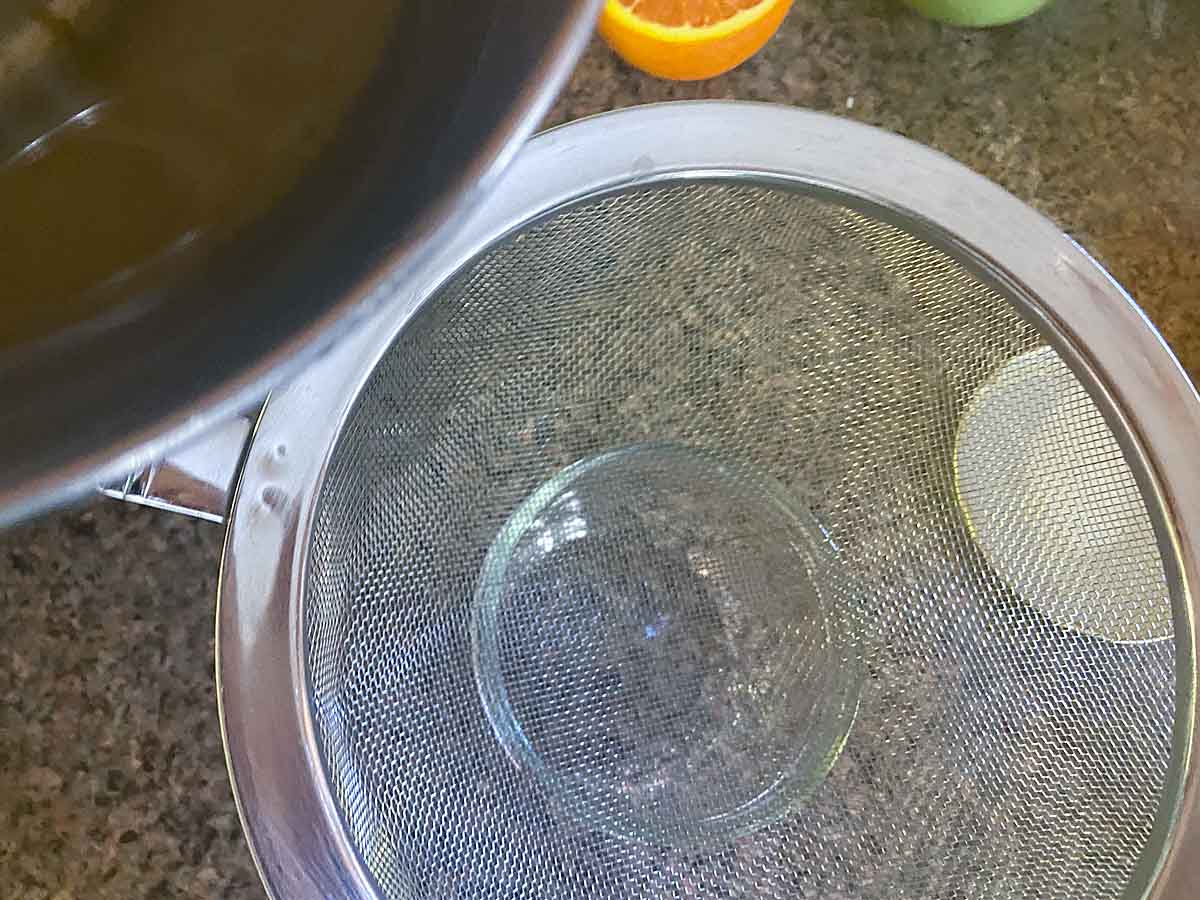
Tips and FAQs
If you are using these for decoration, it is nice to have a variety of sizes.
I slightly preferred the look of the slices dried on the rack rather than parchment. The parchment dried slices had more of a mat look on the back side (not that this is a huge problem).
How to Slice
One trick to perfecting your Candied Orange Slices is to slice them just right—not too thin nor too thick. The thicker they are, the longer it will take for them to dry and they just won’t look as appealing. However, if you slice them too thin, they might not hold shape during the boiling process. I settled on 1/8 inch, or maybe slightly thicker, as the happy medium.
I used a mandolin and found that setting it to 1/4 inch gave me approximately 1/8 inch citrus slices. (For anything else 1/4 inch gives 1/4 inch slices–go figure.) For fruits with seeds, like my kumquats, you may need to check between slices and remove the seeds. And since it can be easy to slip and cut yourself using a mandolin, consider using the metal mesh gloves that help protect your hands. 
A sharp knife can also be used to cut the fruit. Especially if you aren’t making a lot.
I discarded the ends of the fruits, since I was going for the stained glass look rather than the candied rind look.
Storing Candied Slices
I’ve stored these at room temperature for a week with good results. For longer storage I’d be inclined to pop then in the refrigerator or freezer. My guess is that if you get the temperature to 245-250F as per my instructions, the water content is reduced enough that they are pretty effectively preserved–but I can’t find any science to back this up.
Cleanup
One of the nice things about cooking with sugar is that it is water soluble. This means that utensils that get coated in stickiness can be put into water (assuming they are water safe) and the sugar will dissolve off.
After making this recipe, I stuck my drying rack upside down in a water filled lasagna pan to allow the sugar to dissolve!
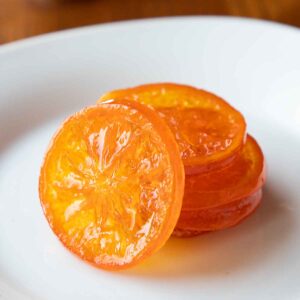
Candied Orange Slices
Ingredients
Simple syrup
- 1 cup sugar
- ½ cup water
Citrus
- 1-2 dozen smaller orange citrus slices I used kumquats and mandarins
Instructions
- Make your simple syrup. In a 1 quart saucepan, combine sugar and water. Stir until combined, then heat on medium until mixture reaches approximately 225F. Be sure not to stir the syrup after it boils, since that can cause crystals.
- Pre-boil your orange slices. While the syrup is heating, bring a couple of cups of water to a boil. Drop the orange slices and boil for two minutes. After two minutes, remove orange slices to an ice bath to cool. This step helps to reduce bitterness.
- Boil the orange slices in the simple syrup. When the sugar mixture reaches 225F, add the boiled and cooled citrus slices and adjust the heat to a low boil. Don’t stir, but you can press down on the slices if they seem to be floating too much. Turn top slices over occasionally.
- When the syrup reaches 245-250F, take the pan off the heat. Use a fork to take the slices out one at a time and set them onto a wire rack (ideally) or parchment (second choice). Let them cool and solidify for 30-60 minutes.
- If you want to save the syrup (at this point, when cooled, it will be a tacky, stretchy solid, not a syrup), add a few tablespoons of water as soon as the slices are removed and stir vigorously to incorporate. Be careful since the syrup may splatter. You can reuse the syrup for one more batch of slices (after two it becomes too bitter) or as a simple syrup for drinks or recipes.


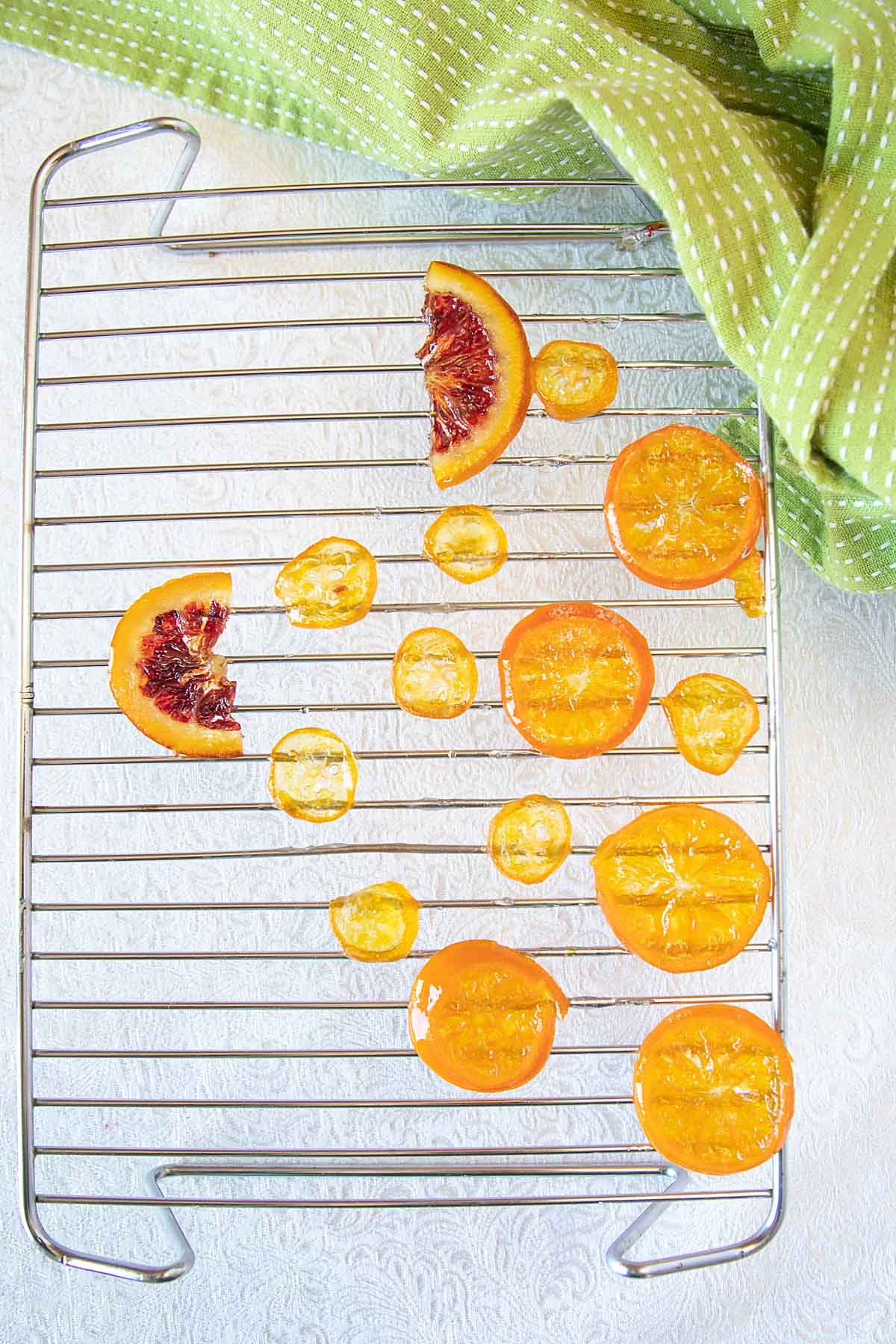
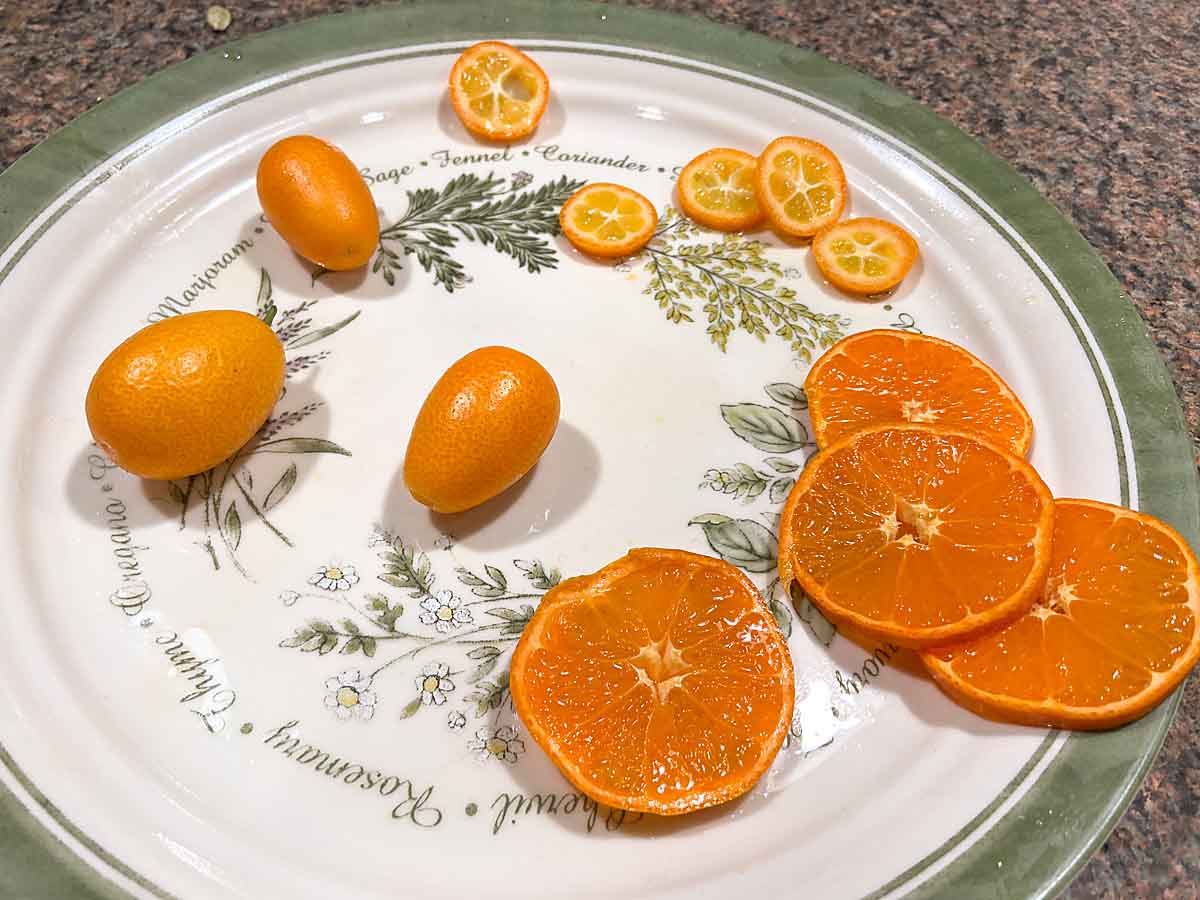
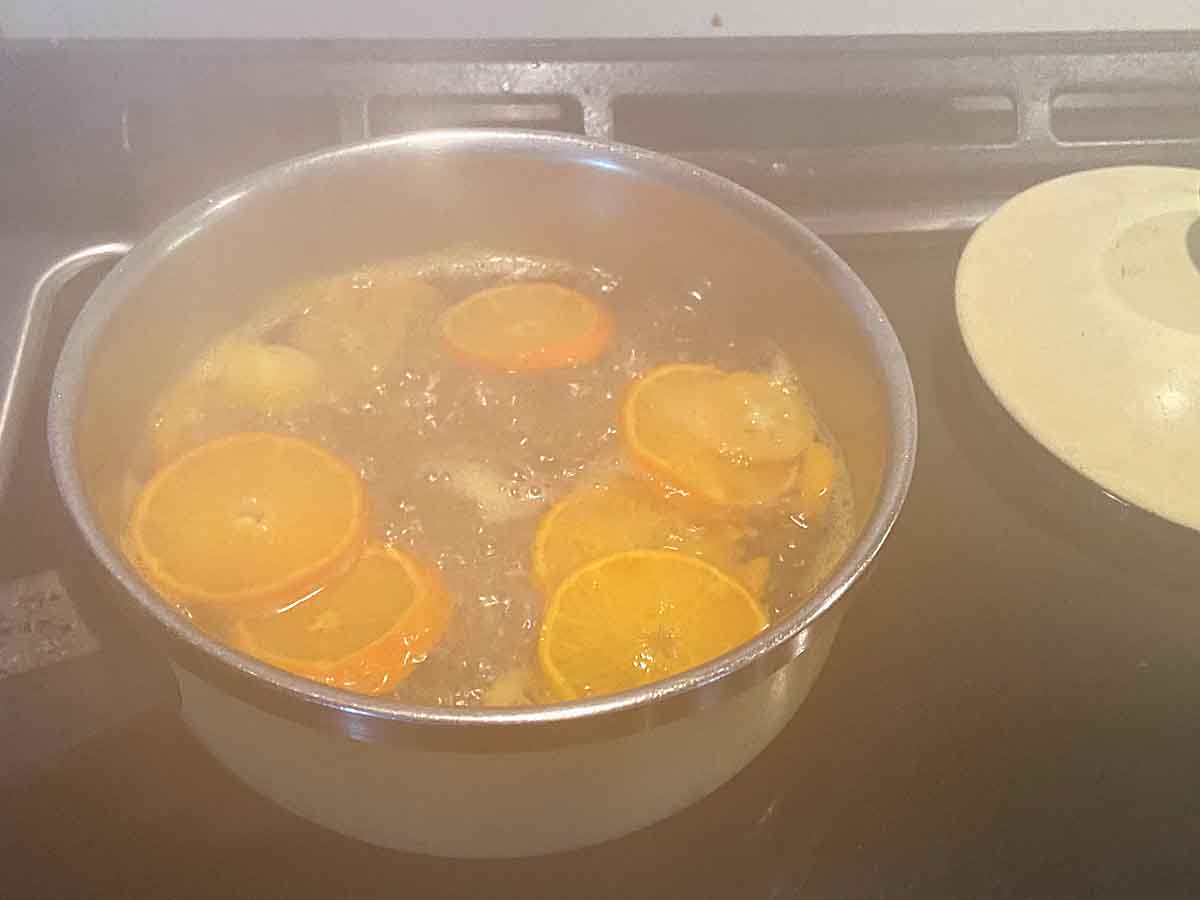
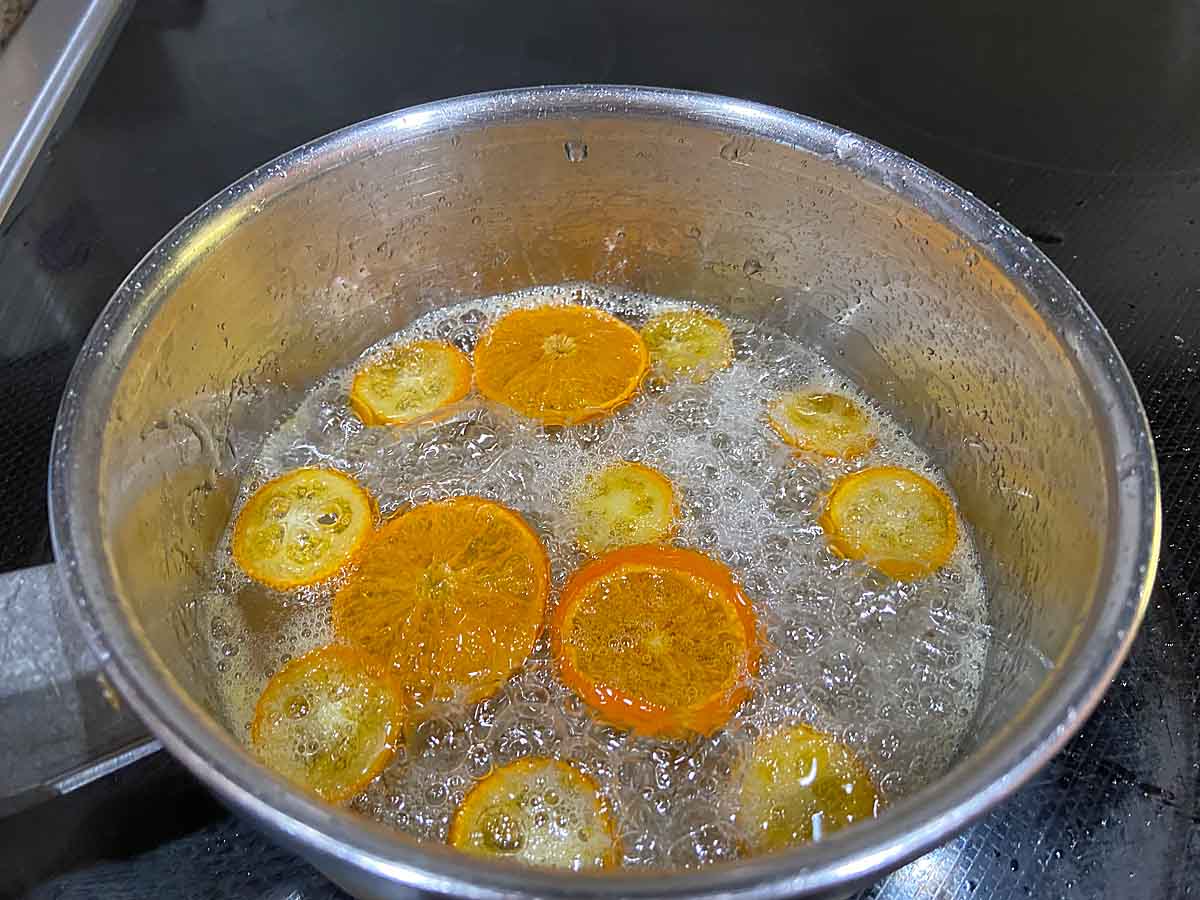
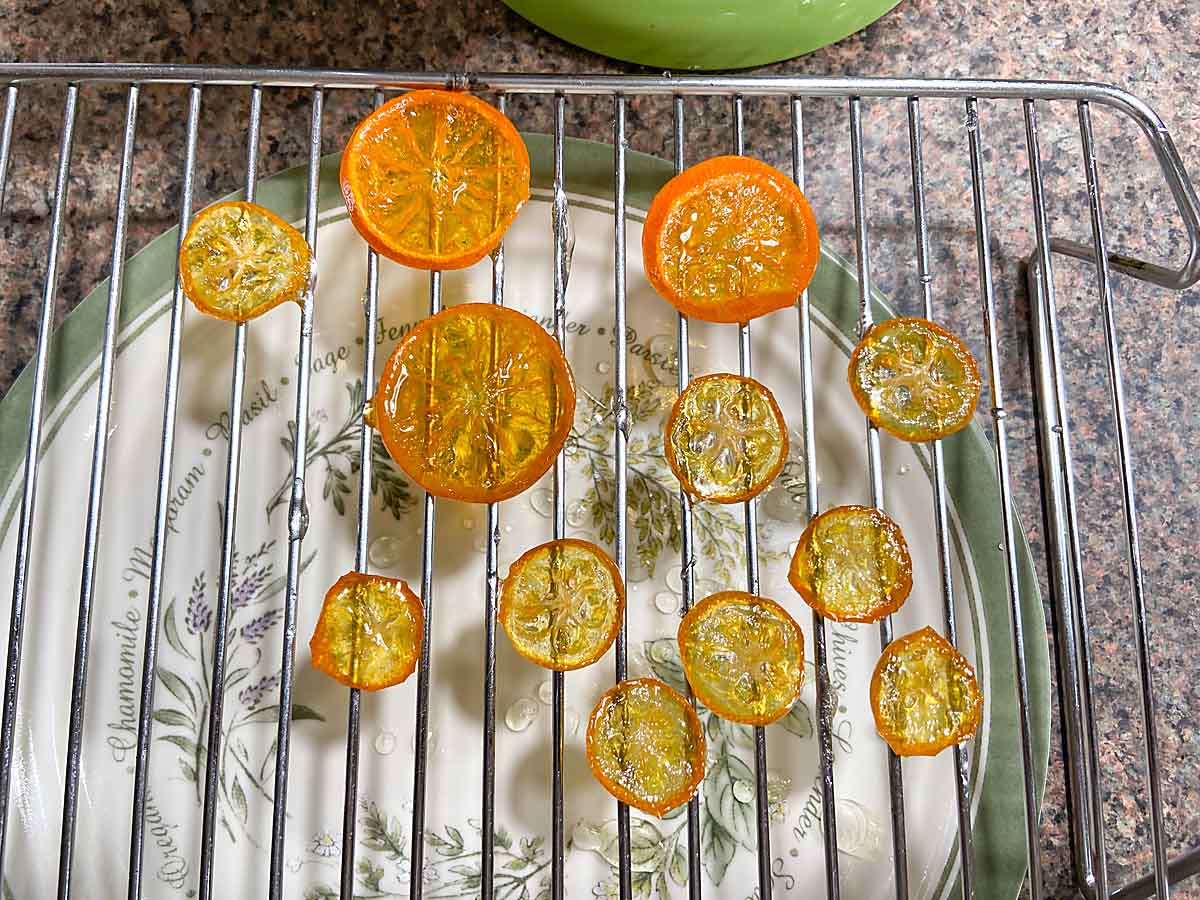
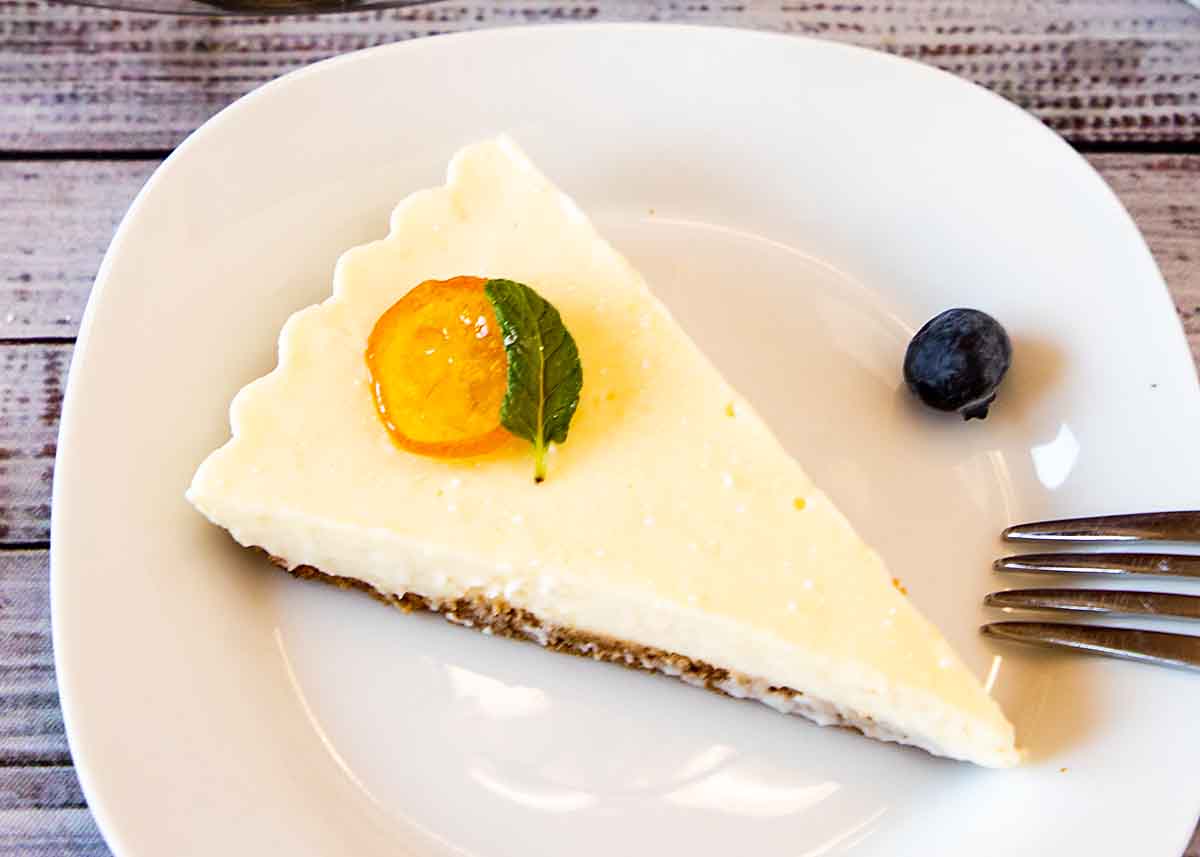
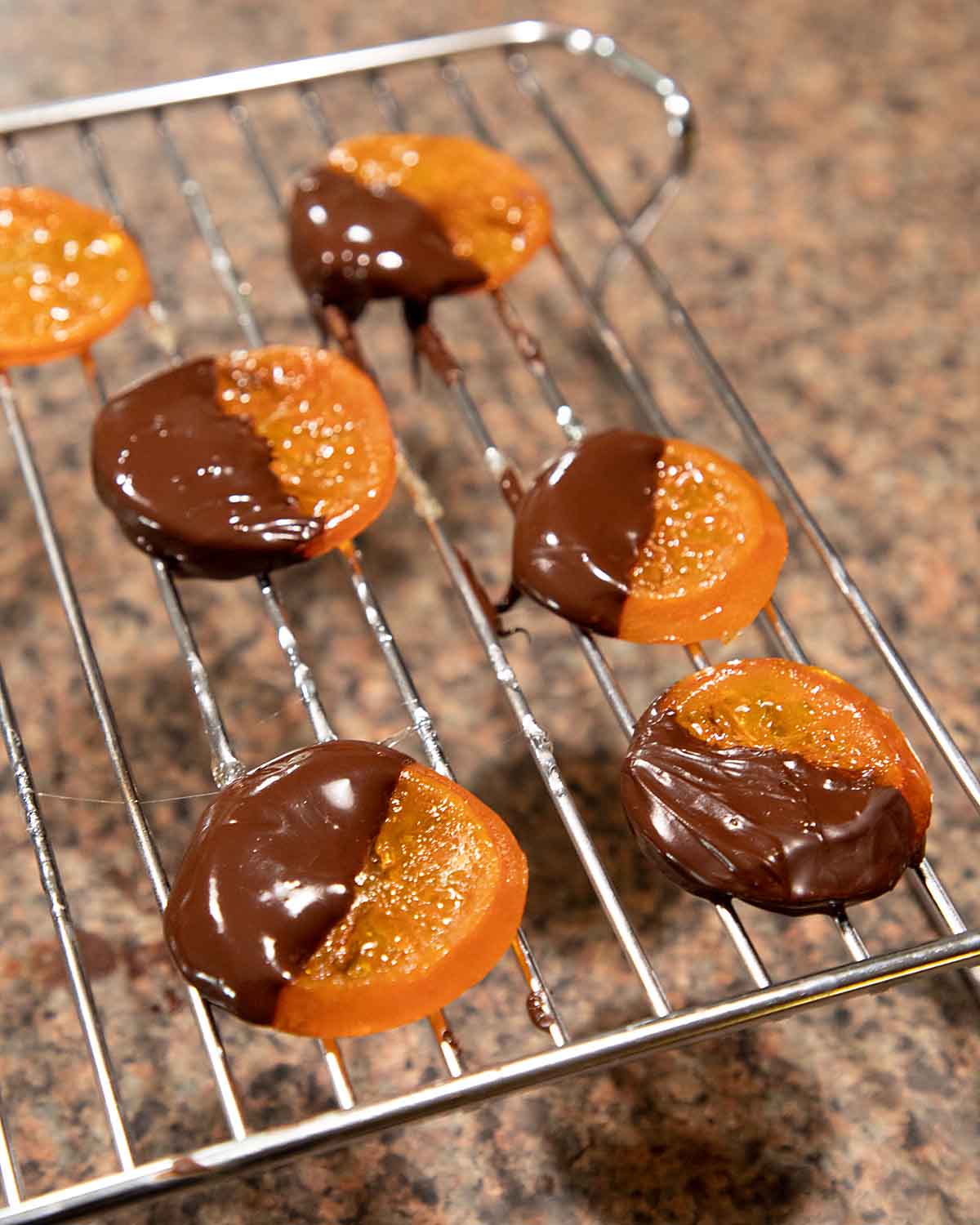
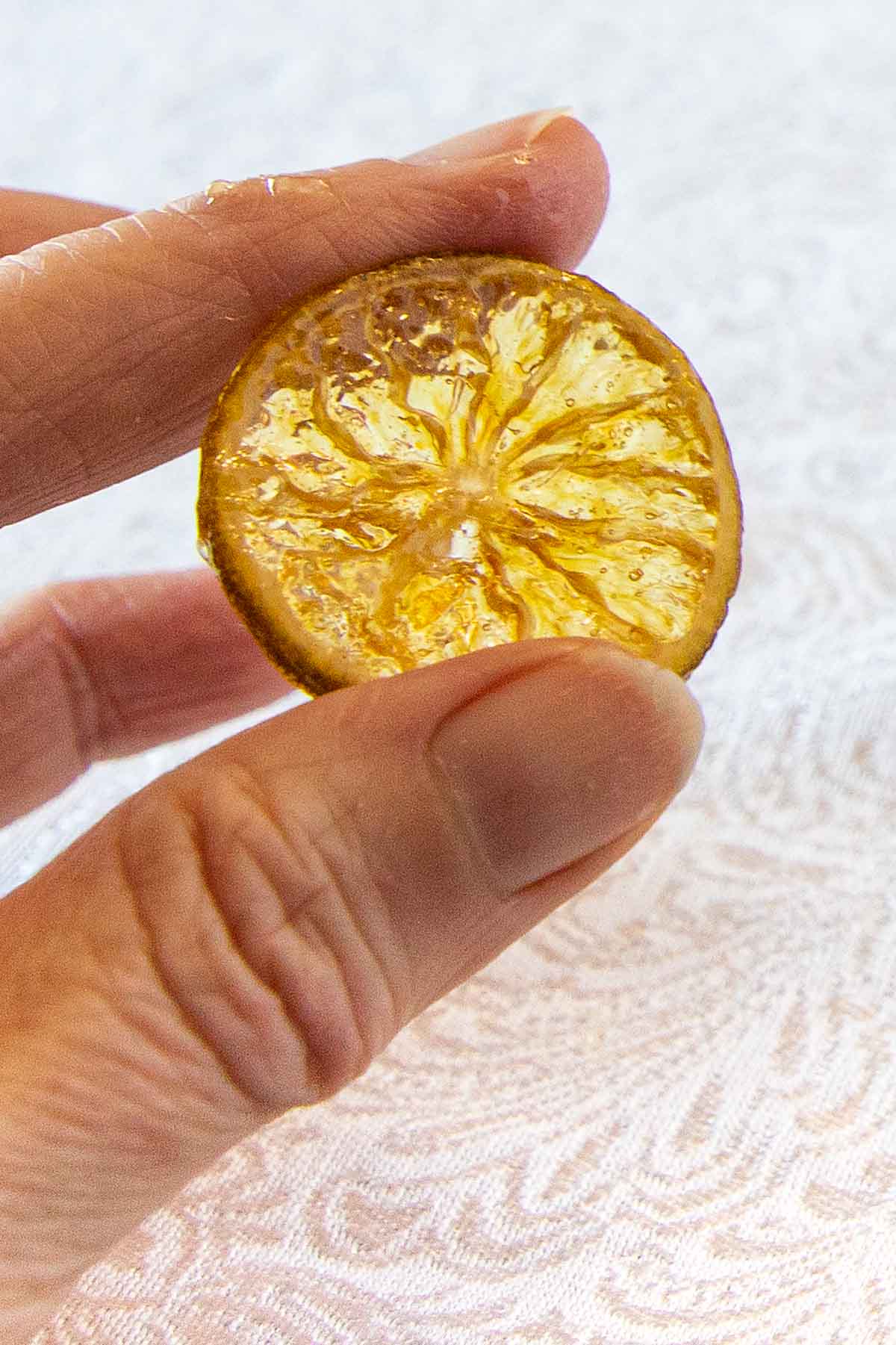

As I work my way through this process, another question has emerged. I’m trying to duplicate Bissinger’s “Glaceed Oranges au Chocolat” (out of this world, but can send a person directly into bankruptcy). Their orange slices exhibit no stickiness whatsoever and are stable at room temperature, whereas my attempts, while delicious, remain sticky and somewhat limp. Any suggestions?
Sorry for the late reply–just saw this. The stickiness is a direct result of the final temperature of the sugar. I was going for something that was shiny but still pliable. But if you’d like something that is harder and not sticky like a lollipop, that temperature would be about 300F (hard crack). Another reader reported liking the results at about 270F which would be between the two.
If you’re up for a science project, you might take some slices out at different temperatures and see how they compare. In fact, now that the holidays are almost over I may try this myself and report back!
Can the simple syrup be saved and re-boiled for a subsequent batch of candied slices?
If there’s enough left you can do a second batch with the syrup but you pick up some extra bitterness–even if you’ve done the pre-boil of the orange slices. Since I’m someone who doesn’t like bitter flavors, I usually start with new syrup. For other people, it might not matter as much. Have fun!
My first batch was rock hard from letting the temperature reach 150. After googling, 150 is hard ball stage in candy making, soft ball is 135. Pulled the 2nd batch out just as it reached 135 and they were much better.
I actually suggest going to the firm ball stage, which in centigrade is about 120-125C. That’s the stage people typically take caramels to and it is pliable but not runny. 150C is hard crack which is used for lollipops so I can see why yours were too hard! 135C is soft crack and if you liked the results go ahead and stay with that–I imagine the gloss was beautiful! Thanks for commenting–this should be very helpful for anyone converting to centigrade!
I have been searching for a recipe for these after I boght some at Trader Joe’s. And I thought to myself, how hard can they be? After reading the reviews, I believe I will now proceed to make some as the orange tree is loaded with fruit that is too bitter to eat. I will also be making orange jelly. Thanks for the reccipe!
You’re welcome–hope you enjoy!
I remember visiting my daughter at ASU and juicing the sour oranges we picked on campus which had to be mixed with sugar and water before drinking. But a fun challenge–enjoy your harvest!
Thanks for the recipe! These are delicious. I am curious, though, if you have any thoughts on how to intentionally trigger the crystallization of the sugar… long ago in Spain I had candied fruits that were not shiny and gooey, but were firm (but not hard) and dry. Any thoughts?
You can do that by stopping the cooking at a lower temperature and then dipping them in sugar when they come out. It’s actually how most candied fruit is made but I was trying to achieve a glossy finish in these for the visual appeal and the more candy-like nature.
I’d need to experiment to be sure, but I’m thinking you might take them out of the syrup around 230F. THen they’d have to be dipped in sugar (which you are looking for anyway) because the syrup is still a liquid. In that case you’d probably want to add the oranges to the syrup earlier, perhaps as soon as it starts to boil so that the sugar has time to permeate. I’d have to experiment to be sure, but this would get you close.
Would honey work instead of sugar? Make any difference?
Wow, this wins the interesting question of the day award. I personally had no idea, so I went out and did a google search. It seems that people are out there making candy, using honey like sugar, and taking it hotter than this recipe does. So I think this should work (though nothing is for sure until it’s tried). If you try it and get a chance to report back, I’d love to hear how it goes.
It takes time but so worth it!
So delicious and pretty.
I’m a huge fan!
Thank you!
Thank you so much Anda!
Not sure what I’m doing wrong, but I’ve made this twice now and both times the syrup burned before it reached 240°F. I guess I’ll have to make a chewier version with cooler syrup, because this is way too difficult to clean off my saucepan. It solidifies almost instantly.
Sorry this was hard for you. Candy is definitely a harder type of cooking but this specific recipe is usually not that difficult.
It’s actually physically (chemically?) impossible for syrup to burn at 240 F–the burning point of sugar syrup is up around 350F. I can think of a few things that could cause what you are experiencing however. First, your thermometer may be inaccurate. Many can be recalibrated so you might contact the manufacturer to get testing and recalibration instructions. Another thing that could be happening is that areas of your syrup are heating faster and burn while the area you are measuring is lower (though that much difference would be a stretch). I see this sometimes in making caramel, which is heated much hotter. Reasons for uneven heating might be heating at too high a heat or using too thin a pan. As a tip, if the sugar is turning gold and/or smelling like caramel, that means you are up around 320 F, which is way too hot for the recipe. Here is the link that’s very good about stages of sugar https://www.exploratorium.edu/explore/cooking/candy-making-stages
Finally, as long as the syrup is just hard and not burned on, you can simply soak the pan and the hard syrup will dissolve in water. This may take a while–even overnight, and a change of water or two, but it’s how I always clean my candy pans, even those I make caramel in.
Hope this helps you or a future candy maker.
This worked really well! It took a surprising amount of time to get to 250 F when the orange slices were added so be patient.
My slices stuck to the rack, so I used a hair dryer to soften them up enough to get them loose without ruining their pretty surface.
The leftover syrup tastes dreamy and I’m absolutely saving that for cocktails.
I’m so glad you enjoyed this Jo! The temperature the burner is at will influence the time it takes to get to 250 but for a first time, going slower is absolutely the way to go.
Orange is my favorite fruit and this is a wonderful, easy, inexpensive candy. Had some oranges on hand nearing their expiration. Put this together while fixing breakfast. Haven’t dipped them in dark chocolate yet, but just by themselves the flavor just explodes. Easy to make. Only 3 ingredients without the chocolate. Just enough sweet taste without being rich. Plan to use this regularly as I need it to use up oranges. BTW I used small oranges because I didn’t have any clementines and they worked well! Might be because they were not fresh from the store and super juicy.
Hi, I made some candies chocolate dipped oranges, they were delicious BUT came out too soft; I was hoping they would be more firm. Do you have an idea of why this might have happened? I want to try again. Haha.
Thanks!
HI Melissa. Ending up too soft would be because the syrup didn’t get hot enough. The final temperature is directly related to how ‘firm’ the syrup is when it cools.
Did you use an instant read thermometer? If you add the orange slices when the syrup is 225F and then simmer it until the syrup gets to 245-250F they should come out right, assuming your thermometer is accurate.
Sometimes a thermometer will lose accuracy after a while. You can test yours by dipping the end in ice water and seeing if it reads 32F. Most can be recalibrated if not but you’ll need to check with the manufacturer for instructions.
More unusual issues would be that the orange slices weren’t in the syrup long enough for it to infuse throughout. THat’s not likely, but possible if it was cooking at a very vigorous boil and went from 225 to 245/250 really fast. Another possibility would be that the syrup was very uneven in temperature–so maybe was only hot enough around the edges. In that case a heavier guage pan might help, or you can carefully “swirl” the syrup in the pan to even out the heat. Candy makers are warned not to stir boiling sugar since that can make it crystalize but swirling is gentle enough in my experience not to be a problem.
Feel free to write again is you need clarification or have more questions. Good luck. Candy making is considered a more advanced cooking skill but is really fun after you get past a failure or two!
These are delicious! I tried a dusting of citirc acid powder (used to make sour candies) that I happened to have from a different food adventure. Turns these from “hard to say no to” to full on addictive.
Glad you enjoyed these Dave! I have some citric acid powder in my pantry, so I’ll have to give this a try!
I had a really hard time getting the tempature to go up after adding the oranges, unless the stovetop was on high the temp would just drop, do you know why that would be? I doubled the syrup recipe as it didnt seem enough for 2 dozen slices
In fact, after adding the oranges the temp dropped to 210 and hasn’t gone up from there, I’m posting these as I’m making them as I’m worried I’m doing something wrong
That’s natural when you add something cool! If the temp is going up super slowly you can turn the heat up—stoves will vary in how hot the burners heat at different temperatures. Just watch it carefully as it nears the final temperature then. Good luck.
The temperature change is a reflection of the concentration of sugar in the water–plus the fact that you just added orange slices that were at room temperature or cooler. WHen you add the orange slices, some liquid moves out of the slices and Until enough of the extra water evaporates out of the syrup, the temperature can’t go back up. THis link may help explain this more: https://www.craftybaking.com/howto/candy-sugar-syrup-temperature-chart
I usually use small slices–like mandarins and am guessing that if you used full sized that would slow things down more. It should be okay to turn up the heat some but I wouldn’t go all the way to high because you risk your syrup heating less evenly or even boiling over. IF you end up taking them out early they won’t be as infused and glossy, but you can always dip in sugar to compensate and they’ll still be tasty.
Hi, My sweet mom was extremely frugal. Born in 1916 you know she learn survival skills during her lifetime. This orange candy slices were one of her favorite candy to make us during Christmas.
Making orange jam tonight & boiling orange skins as we speak for orange candy slices . Thank you.
I love when food brings back good memories, Mary! Enjoy!
This recipe is so wonderful and the Candied Oranges came out tasting delicious with the perfect consistency. Even better than those that are occasionally for sale in the specialty market.
Highly recommend!
Hi – These look great and thanks for the tips and all the detail. Wondering if you can help with sourcing kumquats, I have been searching high and low. Where did you find yours?
I have gotten them from Melissa’s produce, though shipping can be expensive. I do find them at grocers, even in Wisconsin, when they are in season–which happily they are now. Here the Hispanic grocers or specialty fruit markets are more likely to carry them–I usually call first. Good luck.
Love the tip about boiling first!
These look so delicious. I have never attempted in making candy peels and now I have your recipe to start. Thanks for sharing.
Ohhh I want to try making these, they are a good edible decor for cakes
I’m interested in making Stollen which calls for candied fruit. I’ve read that homemade candied fruit is far superior than store bought. Your recipe seems pretty simple. I can’t wait to try it. Adventures in baking 😉
Sounds like fun Randy! For Stollen you might want the fruit slightly softer. WHile I haven’t tried it, my gut would be to cook it to a lower temperature–perhaps 235-240F, then roll in sugar.
Were they sticky? I want to try this but for what I have in mind, they need to be dry.
They are sticky Tandy. But for drier, you should be able to cook to a higher temperature–probably 270 F (135 C). This would also make them more crunchy and less chewy but if that works for you I don’t see why this wouldn’t work. You might also put them in the boiling syrup later in that case, maybe when it’s around 240 F (115C). I’d need too test to confirm, but in theory this should work. Basically, you’d just be taking out more water. If you try it let me know how it goes!